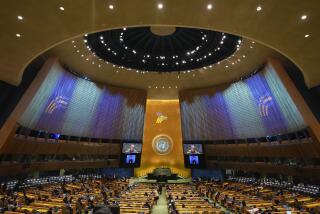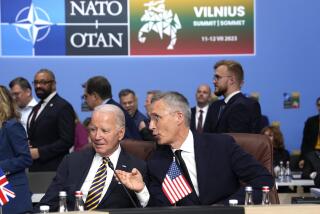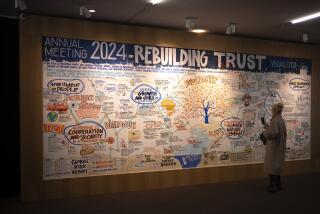World Leaders Vow to Help Rebuild Balkans
SARAJEVO, Bosnia-Herzegovina — In a moment heavy with both history and hope, the United States joined with more than 50 other nations and international organizations Friday to begin the massive task of rebuilding southeastern Europe.
“The war [in Kosovo] is over, we have to build a better peace for the Bosnians and all the people of southeastern Europe,” President Clinton said during a daylong visit to Sarajevo, the capital of Bosnia-Herzegovina, which itself endured a bitter 3 1/2-year war earlier this decade. Clinton returned to Washington shortly before midnight.
In what aides said was an attempt to challenge European countries, which are expected to carry the major financial burden of the Balkans Stability Pact, Clinton presented one of the few detailed proposals offered Friday.
It included a $150-million fund to coax U.S. investors into the region, $130 million to support small and medium-sized businesses in the region, and tariff reductions that would open U.S. markets for exports from the area.
According to Bosnian authorities, Friday’s launch of the ambitious development initiative drew 17 heads of state, 13 prime ministers and more than 50 separate official delegations.
While Dutch Premier Wim Kok and his British counterpart, Tony Blair, also spoke in detailed terms of potential aid initiatives, organizers stressed that the meeting was not intended as a pledging conference. A pledging conference earlier this week in Brussels to solicit short-term aid for Kosovo’s recovery netted $2 billion, including $500 million from the United States.
“We have gathered in Sarajevo to mark a turning point in the recent history of the region,” said meeting chairman Martti Ahtisaari, president of Finland, which holds the rotating presidency of the 15-member European Union. “[We] envision a Europe at long last undivided, prosperous and free.”
But recognizing just how far off such a goal was, he called Friday’s meeting “the starting gun of a marathon.”
For the United States, the initiative contains a heavy strain of self-interest. The region has lurched in and out of war for much of this century, four times alone in the past decade. The last two of these conflicts, in Bosnia-Herzegovina and Kosovo, have ended with the presence of U.S. military forces.
Friday’s meeting marks the third time since the end of World War II that the U.S. has led an international effort to revive part of Europe. In many ways, the challenges of southeastern Europe are the most difficult. After putting Western Europe back on its feet with Marshall Plan aid beginning in the late 1940s and launching Communist nations of Central Europe on the path to free market democracies in the early 1990s, the target this time is one of the continent’s poorest, most strife-prone regions.
The pact’s underlying philosophy is that the world’s rich and successful democracies offer assistance in three broad fields--economic development, strengthening democracy and security--according to priorities worked out jointly by nations of the region. In return, the receiving countries pledge to accelerate political reforms and market liberalization measures needed to spur growth, improve living standards and better integrate into the global economy.
Eight recipient nations have signed the pact--Slovenia, Albania, Romania, Bulgaria, Macedonia, Bosnia-Herzegovina, Hungary and Croatia. Serbia has been deliberately excluded from the plan as long as Yugoslav President Slobodan Milosevic remains in power.
However, Western-leaning Montenegro, the other republic in the Yugoslav federation, attended the conference as a guest and would be eligible for assistance under the plan. U.S. officials declined to elaborate on how this would be achieved.
Much as the Marshall Plan before it, the pact is deliberately structured to force recipient countries to cooperate with one another.
The leaders met in the city’s newly rebuilt Zetra Olympic Arena, where German figure-skating champion Katerina Witt won gold in 1984 and where Serbian artillery shells landed with deadly destruction less than a decade later.
As the inaugural event in the refurbished building, Friday’s meeting symbolized the sense of renewal in a city heavily damaged during its three years under siege earlier this decade. With the war in Kosovo over and the power of Milosevic seemingly on the wane, many citizens see the Stability Pact as a ray of hope.
Sarajevo’s streets were sprinkled with posters declaring: “The Stability Pact: Peace, democracy and prosperity is our hope and our goal.”
Despite the cautiously upbeat mood among the citizens of Sarajevo and delegates to Friday’s meeting, the task of reshaping the Balkans is daunting.
The countries involved are small, the region’s infrastructure is weak, and the labor force lacks the basic educational skills and industrial tradition that were present in Western Europe in the 1940s and in Central Europe half a century later. There also appear to be few national leaders in southeastern Europe approaching the caliber of Konrad Adenauer, Robert Schuman, Vaclav Havel or Lech Walesa, all of whom helped shape the transformations of their regions.
Widespread corruption and bureaucracy drag on business opportunities. German auto maker Volkswagen, which reopened a factory here with great fanfare about a year ago, is limping along.
“We’ve got low production targets, but we’re making them,” said Kurt Rippholz, a company spokesman at the corporate headquarters in Wolfsburg, Germany. “It’s not easy in this situation.”
And despite the glowing rhetoric around the fringes of Friday’s summit, the visible signs of reconstruction and Clinton’s high-profile visit to a multiethnic high school, Bosnian Muslims, Croats and Serbs agree on one fact: Genuine ethnic reconciliation remains a myth.
One resident recalled an incident in another multiethnic school that he said captured prevailing conditions far better than Clinton’s experience. He said that pen-and-pencil cases provided by a Kuwaiti donor were distributed to all first-graders at an elementary school in a mainly Muslim neighborhood--all, that is, except to the lone Croatian girl in the class.
“The Stability Pact is a framework that offers a chance but doesn’t guarantee success,” said Bodo Hombach, German Chancellor Gerhard Schroeder’s former chief of staff, who was named special coordinator for the Stability Pact’s operations. “There is a lot of work ahead of us.”
More to Read
Sign up for Essential California
The most important California stories and recommendations in your inbox every morning.
You may occasionally receive promotional content from the Los Angeles Times.










